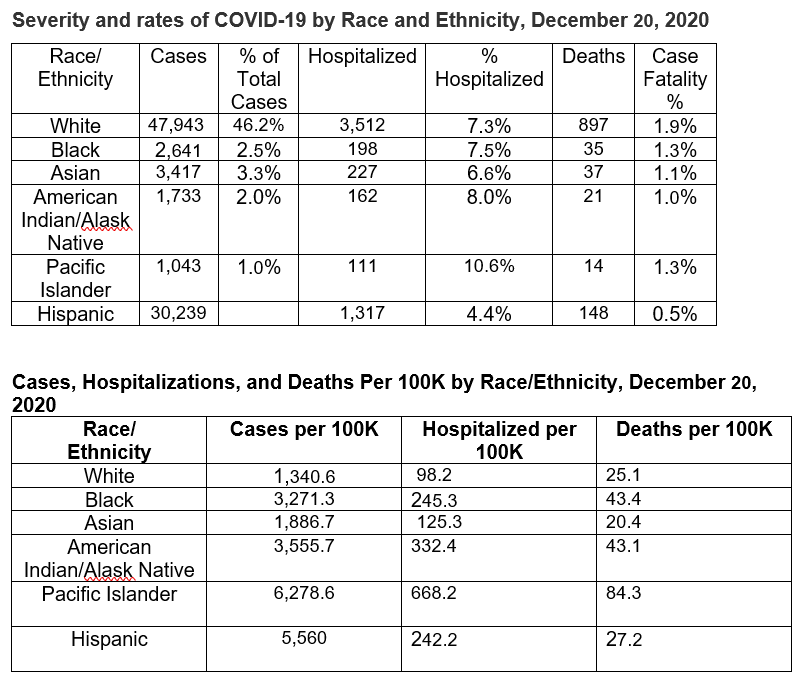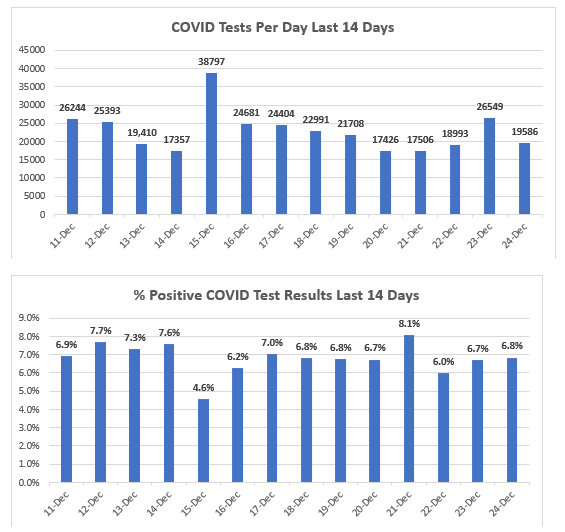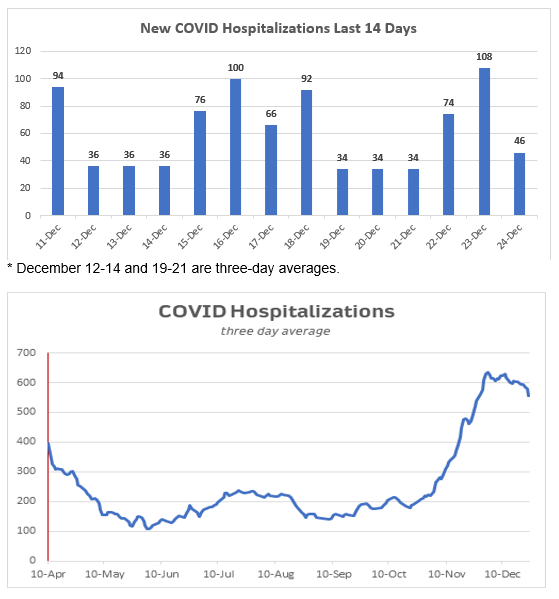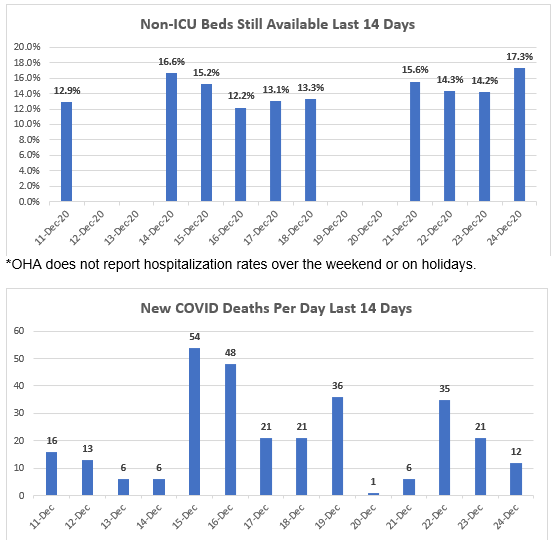|
December 24, 2020
I hope that you and your loved ones are doing well, staying healthy, and looking out for your neighbors and friends in these difficult times.
Please accept my warmest wishes for a meaningful, deeply spiritual Christmas for those who celebrate it and a time of love, reflection, and sharing for all.
My Christmas gift for you will be a day off from this newsletter tomorrow! I’m sure you’ll be grateful for the respite.
Please stay safe, and let me know if you have any questions about information in today’s newsletter.

TODAY’S CORONAVIRUS AND CORONAVIRUS RESPONSE UPDATE
-
New COVID Cases: OHA reports 871 new COVID cases today. OHA reports that there was a delay in processing laboratory results, so case counts today are lower than normal and will likely be higher in the future as a result. This count is a combination of positive test results and those who are presumed positive (see definition below). The cumulative number of cases in Oregon since the beginning of the pandemic is 106,821.
-
Positive Test Results: OHA reports 1,341 positive test results today. (Individuals may have had multiple tests come back positive, and each is now counted separately.) The cumulative total of positive test results since the beginning of the pandemic is 148,469.
-
Total Tests: OHA reports an additional 19,586 test results. Our cumulative total of tests is 2,537,482.
-
Positivity Rate: The average test positivity rate for Oregon today is 6.8%. The national ratio today is 10.6%.
-
Deaths: I’m sorry to have to report 12 additional COVID deaths today. You can read about the Oregonians we lost further down in the newsletter. The total number of COVID deaths in Oregon is now 1,415.
-
Hospitalized: OHA reports 46 new COVID hospitalizations. The cumulative number of those who have been hospitalized with COVID is now 6,168.
-
Vaccinations: 2,794 new COVID vaccines were administered yesterday. So far, a total of 14,524 doses have been administered in Oregon. For more details, go to the OHA Vaccinations Dashboard.
-
Presumptive Cases: OHA is including “presumptive COVID-19 cases” in its reports, consistent with recently amended guidance from the Centers for Disease Control and Prevention. A presumptive case is someone who does not yet have a positive PCR test but is showing symptoms and has had close contact with a confirmed case. If they later test positive by PCR, those will be recategorized as confirmed cases.
-
Other Hospital Information:
- Patients Currently with COVID-19 Symptoms (who may or may not have received a positive test result yet): 530 (30 fewer than yesterday). Of those, 495 (32 fewer than yesterday) have already received a positive test back.
- Available ICU Beds: 181 (11 more than yesterday)
- Other Available Beds: 770 (143 more than yesterday).
- ICU Patients w COVID-19 Symptoms: 109 (6 fewer than yesterday).
- COVID-19 Patients Currently on Ventilators: 59 (2 more than yesterday).
- Available Ventilators: 775 (3 more than yesterday).
-
Dashboards:
-
Today’s National Numbers:
- Total Tests: 239,563,248 (up 1,907,423 from yesterday).
- Total Cases: 18,441,429 (up 202,579 from yesterday.)
- Deaths: 317,513 320,451 (up 2,938 from yesterday).
- These national numbers come from the COVID Tracking Project. You can visit that site here.
-
Additional Brief Updates:
- With the passage of the latest round of federal COVID response, many unemployed Oregonians are wondering what this means for them. What will they need to do to make sure that their benefits continue or are reinstated? When will the new programs go into effect? Legislators received a communication from the Employment Department this afternoon with information about what we know and what we don’t know. For now, we don’t know much . . . Many of the details came together at the last minute and are now being analyzed. The President is talking about vetoing the bill, so nothing can be taken for granted for now. Any brand new programs will require computer programming and rule development, and those will take time. Most of it, however, should be very easy to implement—i.e., those programs that are simply being extended, where individuals have already been accepted and processed. Use the information in the linked email as a starting point—I’ll follow up as we learn more.
- Today’s Oregonian includes portraits of 20 Oregonians that we lost to the pandemic. They come from a number of media outlets from around the state.
- Fortunately, most people who have been infected by the virus do survive it. However, some will continue to bear its scars. KGW’s Morgan Romero shares the stories of five Oregonians who are experiencing serious and lasting effects.
Follow-Up on School Reopening
In last night’s newsletter I shared some late-breaking information about the Governor’s announcement that she wants to allow local school districts to consider their county COVID metrics as advisory rather than mandatory in making their reopening decisions. We’ve known for a while that the Governor would like to get schools back to in-person instruction more broadly, at least for younger children. I agree with that, as we’re seeing clear evidence that remote learning isn’t working well for many kids, especially the younger ones. But it needs to be done in a way that is safe and carefully planned, ideally in coordination with the provision of vaccines to teachers and other school personnel.
The timing (during winter break) and nature of the Governor’s announcement, however, came as an unfortunate surprise. I was able to follow up with the ODE Director and the Governor’s education advisor today and was able to get more details and a better understanding.
We should not expect districts to rush willy-nilly into reopening as a result of the announcement. While the county metrics are now “advisory” rather than “mandatory,” districts will still be expected to create reopening plans that take into account the COVID levels in their area. They won’t necessarily be bound by the COVID levels for the county as a whole if their catchment area has lower levels. However, they will still be required to follow ODE’s Ready Schools, Safe Learners safety guidelines regarding face coverings, distancing, and cleaning (as well as OSHA’s). If they don’t follow those guidelines, they will lose the “safe harbor” from lawsuits that the Legislature gave them on Monday.
They will still need to work with their employees to ensure that the school environment is safe and set up for student success.
The Governor’s Healthy Schools Reopening Councils will convene early in January to work on updates to the reopening plan, with the goal of having updates ready by January 19. I’ll be joining the Council going forward.
This effort—creating a pathway to reopening schools for in-person instruction, at least for younger children and ideally beginning in February, when the next school semester begins--needs to be based on what we’ve come to understand about the disease, about student learning, and about the benefits and drawbacks of remote learning for kids from different socio-economic groups. Reopening our schools safely needs to be a priority for state and federal financial resources. It needs to align with the rollout of COVID vaccines around the state. It needs to include teachers and other educators, along with parents and also students, who all need to feel that their concerns are being heard.
I’ll do my best to keep you apprised.
The Latest OHA Weekly COVID Report: Improving Picture, but Lingering Deaths
OHA released its WEEKLY COVID REPORT on Wednesday. It is again a very comprehensive snapshot of different aspects of transmission of the disease in Oregon over the past week or so. It confirms what we’ve been seeing in our daily reports: record increases in deaths in Oregon (the residual effects of the big increase in infections before Thanksgiving), but improvements in other metrics, which should augur well for the future. It continues to show ongoing disproportionality among racial and ethnic groups.
Here are some of OHA’s broad observations of where we are now, based on data from Monday, December 14 through Sunday, December 20:
During Monday, December 7 through Sunday, December 13, OHA recorded 9,222 new cases of COVID-19 infection—an 11% drop from last week’s tally. This drop was in the context of a 13% decrease in testing and the proportion of tests that were positive falling from 8.1% to 7.4%. Four hundred ninety-one Oregonians were hospitalized with COVID-19 during the week, compared to 494 the previous week. One hundred sixteen Oregonians died in association with COVID-19—down from 133 the previous week. In all, 1,161 of the 95,010 cases reported to date in Oregon have died in association with COVID-19; the case-fatality rate has held steady at 1.2% for several weeks.
During Monday, December 14 through Sunday, December 20, OHA recorded 8,745 new cases of COVID-19 infection—a 5% drop from last week’s tally. Hospitalizations decreased 11%, to 437. A record 186 Oregonians died in association with COVID-19—eclipsing our previous high of 133 two weeks previously. One thousand three hundred forty-seven of the 103,755 cases reported to date in Oregon have died in association with COVID-19—a case fatality rate of 1.3%.
- We see again a reduction in the number of new cases. OHA has reported 8,745 new cases of COVID-19 infection, a 5% reduction from the previous week’s 9,222. This is the second week in a row whose rate of increase is lower than that of the previous week (following seven weeks of increases).
- The number of COVID tests increased to 167,365 (up from the previous week’s 149,243).
- The positivity rate again declined last week from 7.4% to 6.3%.
- The number of new COVID hospitalizations decreased by 11% last week, from 491 to 437, an average of 62 per day (down from 70 per day).
- The number of COVID deaths last week increased to 186 (up from 116 the previous week). This is a new record for one week—the previous record had been 133, set two weeks ago.
- The cumulative death rate since the beginning of the pandemic reached 1,347 on December 20. With the cumulative case rate at 103,755, this is a case fatality rate of 1.3% (up from 1.2%, where it had been for many weeks).
- Among the oldest age group (80+), the fatality rate is much higher: 17.5%, or nearly 1 in 5, of those who test positive for the virus have died of COVID-19.
- Cases are increasingly classified as “sporadic”—meaning that no single source was identified for them. Through October, 34% of cases were classified as sporadic; since then, more than 50% have been sporadic.
The report again provides information about disease symptoms and risk factors; along with racial/ethnic/age/gender demographics. It provides an update on people with intellectual/developmental disabilities and the number of COVID patients at various hospitals around the state.
It no longer includes information on outbreaks in long-term care, workplaces, child care, or K-12. That information is now included in a separate Outbreak Report.
Racial/Ethnic
The report again demonstrates significant disparities among racial groups. You can see this in the charts below, with data that I’ve taken from the December 9 report, the December 16 report, and from this report, which came out on December 23. It allows you to see at a glance the proportion of case counts within different racial groups and ethnic groups (technically, “Hispanic” is not a race and is counted as an ethnic group, with numbers from a separate chart).
To help you understand the racial/ethnic data reported in the weekly report, I’ve also created a chart that shows the hospitalization and death rates per 100K population, along with the infection rates per-100K population for each racial/ethnic group.
You’ll see again how much higher the case rates per 100,000 are for most racial/ethnic groups compared to White Oregonians. Black Oregonians are 2.4 times more likely to contract the disease than are White Oregonians, Native Americans 2.7 times more likely, Latinx Oregonians are 4.1 times more likely, and Pacific Islanders are now 4.7 times more likely. The differences, while still large, have continued to go down slightly from week to week. The differential rate for Pacific Islanders, while very large, is now a third of what it was during the summer.
You’ll also again see that hospitalization rates among those who have contracted the disease are quite a bit lower for Latinx, and somewhat higher for Pacific Islanders than for the population of White Oregonians. Among those who have contracted the disease, the percentage who ultimately die of it is higher for Whites than for people of color.
However, you’ll also see in the final chart that when examined as a proportion of their populations in Oregon, the hospitalization and death rates for Blacks, Native Americans, Latinx, and especially Pacific-Islander Oregonians continue to be disproportionally high. (The hospitalization rate for Pacific Islanders is nearly 7 the rate for Whites, while the death rate is nearly 3.5 the rate for Whites.) Looking at these probability rates helps us to see why it’s so important that special outreach needs to be made to members of these racial/ethnic groups.
  The weekly report also includes graphs showing how Public Health agencies are doing in contact tracing for different racial and ethnic groups. For the most part, the rate of follow-up interviews with Oregonians of color continue to be comparable to the rate with White Oregonians (actually, higher among Latinx Oregonians). Those attempts unfortunately continue to be less successful for Black Oregonians.
Where Are Today’s New Cases?
If we put together the positive test results and new “presumptive” cases reported today, the overall number of new cases reported for is 871. OHA reports that there was a delay in processing laboratory results, so case counts today are lower than normal. Here is the breakdown of reported cases by county for today:
Baker (8)
Benton (9)
Clackamas (59)
Clatsop (3)
Columbia (4)
Coos (10)
Crook (5)
Curry (7)
Deschutes (32)
Douglas (9)
Grant (2)
Harney (2)
Hood River (12)
Jackson (29)
Jefferson (11)
Josephine (32)
Klamath (46)
Lane (67)
Lincoln (16)
Linn (33)
Malheur (21)
Marion (83)
Morrow (5)
Multnomah (188)
Polk (13)
Tillamook (9)
Umatilla (32)
Union (7)
Wasco (11)
Washington (79)
Yamhill (27)
And the Deaths:
Oregon’s 1,404th COVID-19 death is an 89-year-old woman in Multnomah County who tested positive on Dec. 17 and died on Dec. 23 at Legacy Good Samaritan Medical Center.
Oregon’s 1,405th COVID-19 death is a 90-year-old in Clackamas County who tested positive on Dec. 16 and died on Dec. 22 at their residence. The gender of the deceased person was no reported.t
Oregon’s 1,406th COVID-19 death is a 55-year-old man in Clatsop County who tested positive on Dec. 17 and died on Dec. 23 at Pacific Seaside Hospital.
Oregon’s 1,407th COVID-19 death is a 59-year-old man in Hood River County who tested positive on Dec. 3 and died at his residence.
Oregon’s 1,408th COVID-19 death is an 85-year-old woman in Jackson County who tested positive on Nov. 10 and died on Dec. 22 at her residence.
Oregon’s 1,409th COVID-19 death is a 58-year-old man in Klamath County who tested positive on Nov. 19 and died on Dec. 20 at Sky Lakes Medical Center.
Oregon’s 1,410th COVID-19 death is a 66-year-old man in Malheur County who tested positive on Dec. 7 and died on Dec. 21 at St. Alphonsus Regional Medical Center.
Oregon’s 1,411th COVID-19 death is an 87-year-old woman in Marion County who tested positive on Nov. 30 and died on Dec. 20 at her residence.
Oregon’s 1,412th COVID-19 death is an 88-year-old woman in Marion County who tested positive on Dec. 3 and died on Dec. 19 at her residence.
Oregon’s 1,413th COVID-19 death is a 92-year-old woman in Multnomah County who tested positive on Dec. 10 and died on Dec. 10. Location of death is being confirmed.
Oregon’s 1,414th COVID-19 death is a 72-year-old woman in Umatilla County who tested positive on Nov. 28 and died on Dec. 18 at St. Mary Medical Center.
Oregon’s 1,415th COVID-19 death is a 62-year-old woman in Yamhill County who tested positive on Dec. 14 and died on Dec. 18 at her residence.
Additional Graphs:
      **You can find a breakdown of regional availability here.
 Want to See Past Newsletters?
If there was COVID-related information in a past newsletter that you want to go back to, but find you’ve deleted it, you can always go to my legislative website (senatordembrow.com), click on “News and Information,” and you’ll find them all there. Also, if someone forwarded you this newsletter and you’d like to get it directly, you can sign up for it there.

AND FINALLY,
Here again are some resources that you will find useful:
If the above links are not providing you with answers to your questions or directing you to the help that you need, please consider me and my office to be a resource. We’ll do our best to assist you or steer you in the right direction.
Best,
 Senator Michael Dembrow
District 23
email: Sen.MichaelDembrow@oregonlegislature.gov
web: www.senatordembrow.com
phone: 503-986-1723
mail: 900 Court St NE, S-407, Salem, OR, 97301
|